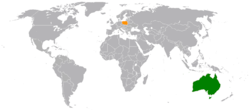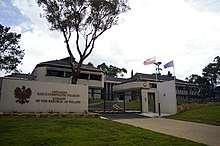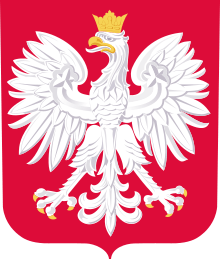Australia–Poland relations
 | |
Australia |
Poland |
|---|---|
Australia–Poland relations refers to the diplomatic relations between Australia and Poland. Over 170,000 Australian citizens are of Polish descent.[1] Both nations are members of the Australia Group and the Organisation for Economic Co-operation and Development.
History
The first Polish citizens to arrive to Australia was in December 1696.[2] The 10 Polish citizens sailed with Dutch explorer Willem de Vlamingh during his exploration of Western Australia. The first known Pole to settle in Australia was Joseph Potaski who arrived to Hobart, Tasmania as a convict, along with his family, in 1803. For the next 40 years, dozens of Polish migrants arrived and settled in Australia.[3]
In the early 1900s, diplomatic relations between Australia and Poland were conducted via-London when Australia was part of the British Empire. Soon after the end of World War I, newly independent Poland established a consulate in Sydney in 1919 and a consulate in Melbourne in 1931. Both consulates, however, were closed immediately after the German invasion of Poland in September 1939.[2] During the war, both Australian and Polish troops fought together in the Italian Campaign, especially during the Battle of Monte Cassino. After the war, Poland re-emerged with different borders than it had prior to the war and established a communist system of government.
From 1947–1966, over 61,000 Polish migrants immigrated to Australia. Many of the Polish migrants were veterans, displaced persons, survivors of labour and concentration camps, prisoner-of-war camps or immigration detention camps.[2] In February 1972, Australia and Poland officially established diplomatic relations. That same year, Poland opened an embassy in Canberra. Australia opened an embassy in Warsaw in September 1973.[2]
Throughout the 1980s, Poland experienced the Solidarity ("Solidarność") movement which eventually contributed to the fall of communism in the country. During that time period, over 25,000 “Solidarity” migrants immigrated to Australia.[2]
High level visits


The highest visit occurred in September 2000 when Polish President Aleksander Kwaśniewski paid a visit to Australia and attended the opening ceremony of the 2000 Summer Olympics being held in Sydney.[4] In May 2013, Polish Foreign Minister Radosław Sikorski paid an official visit to Australia. The visit was soon reciprocated by Australian Foreign Minister Julie Bishop in March 2014, at which time both nations signed a Working holiday visa agreement.[1] In 2013, both nations celebrated 40 years since the establishment of diplomatic relations.[2]
Bilateral relations
Since establishing diplomatic relations in 1972, both nations have signed numerous agreements such as an Investment and Promotion and Protection Agreement (1991); Double Taxation Agreement (1991); Extradition Treaty (1999); Air Services Agreement (2005); a Joint Communiqué on Cooperation in Environmental Technologies, Goods and Services (2006); and a Social Security Agreement (2010).[1] In 2012, Australia donated A$500,000 to the Auschwitz-Birkenau Foundation to preserve the death camps of Auschwitz-Birkenau in Poland.[5]
Trade
In 2014, trade between Australia and Poland totaled A$1,077 billion.[1] Australia's main exports to Poland include coal, copper ores and concentrates, zinc ores and concentrates and medicaments. Poland's main exports to Australia include silver and platinum, mechanical handling equipment and parts, goods vehicles and passenger motor vehicles.[1]
Resident diplomatic missions
- Australia has an embassy in Warsaw.[6]
- Poland has an embassy in Canberra and a consulate-general in Sydney.[7]
 Embassy of Australia in Warsaw
Embassy of Australia in Warsaw Embassy of Poland in Canberra
Embassy of Poland in Canberra Consulate-General of Poland in Sydney
Consulate-General of Poland in Sydney
See also
References
- 1 2 3 4 5 Poland country brief
- 1 2 3 4 5 6 The history of Polish-Australian relations
- ↑ History of Polish immigration to Australia
- ↑ Meetings of the President of Poland during his visit to Sydney
- ↑ Australia to Contribute to the Auschwitz-Birkenau Foundation
- ↑ Embassy of Australia in Poland
- ↑ Embassy of Poland in Australia

